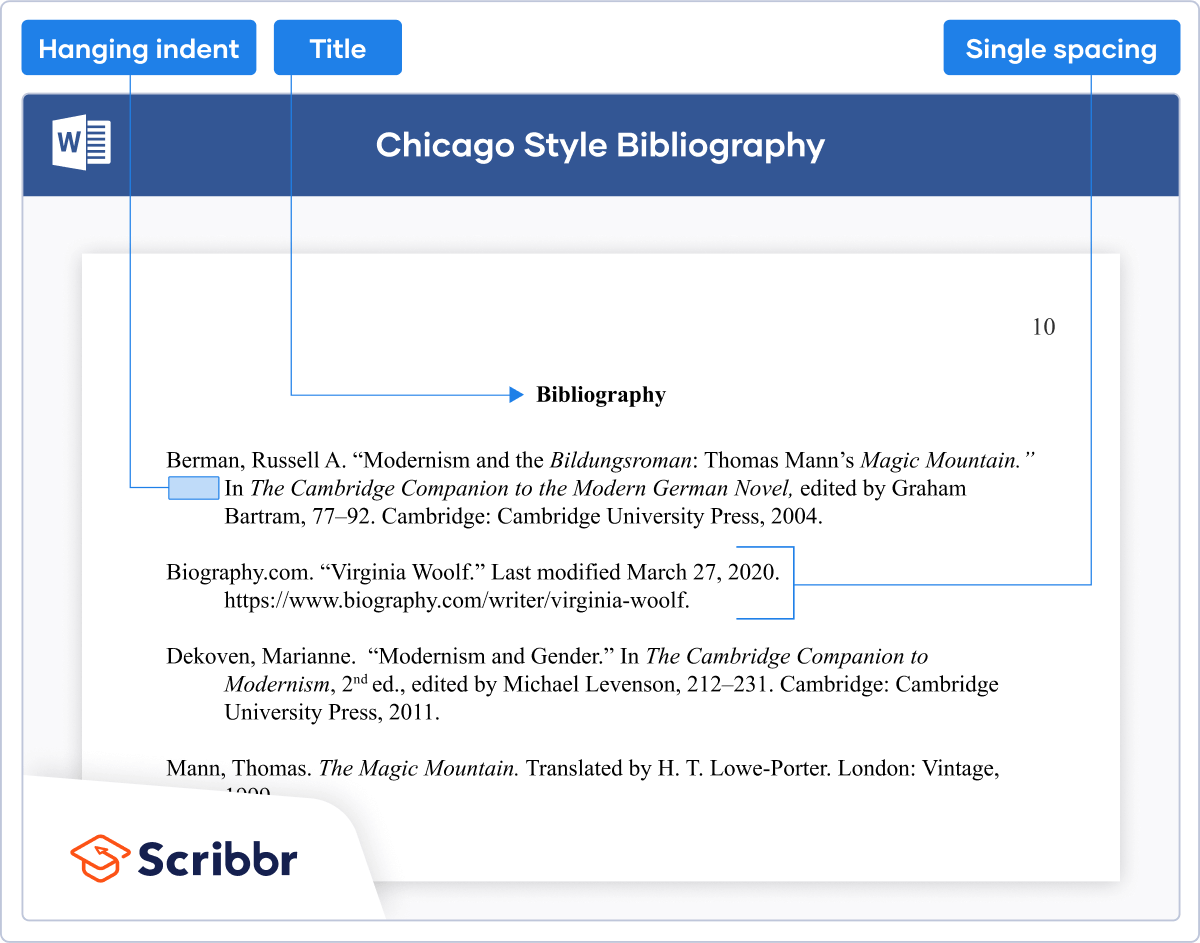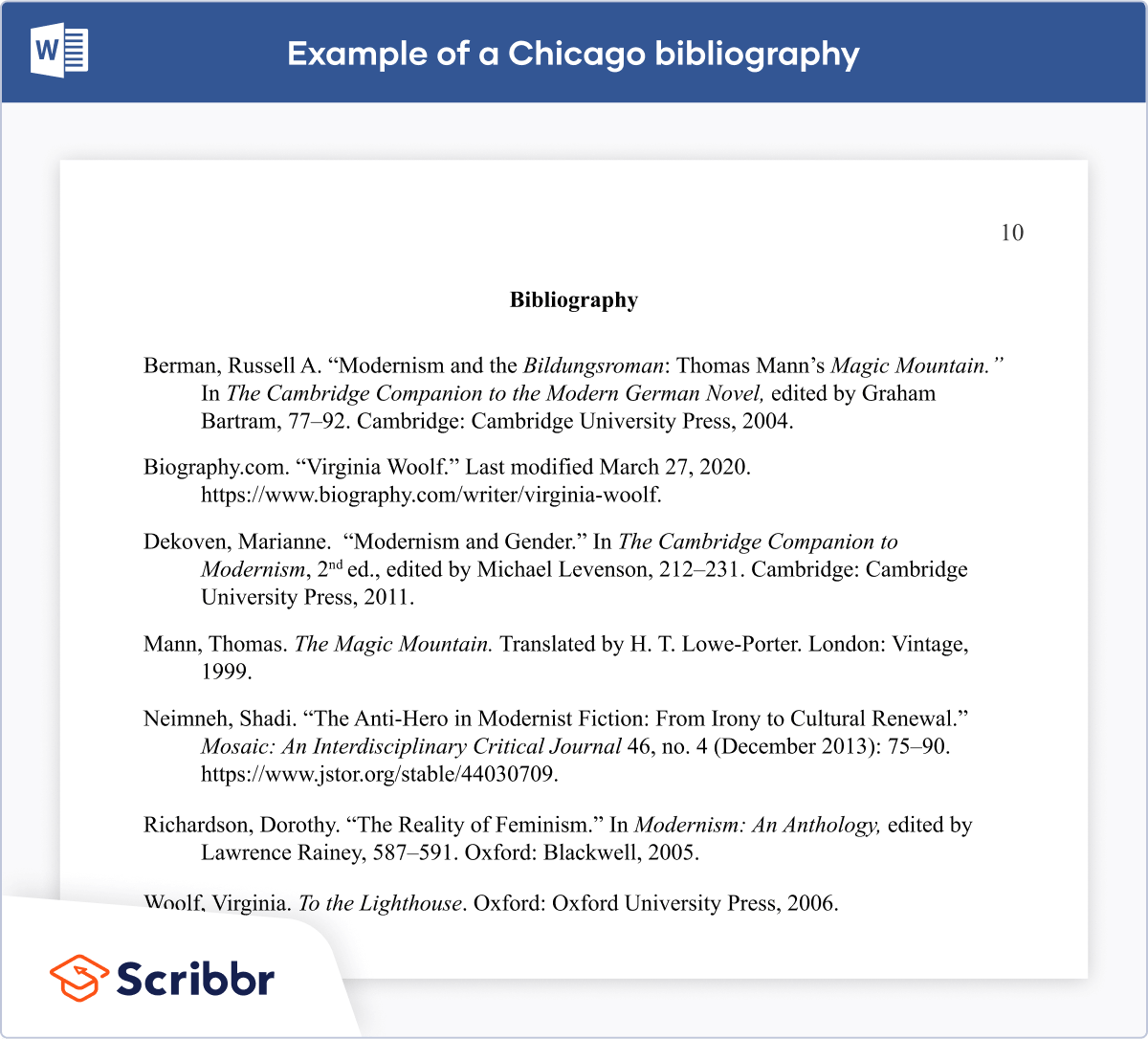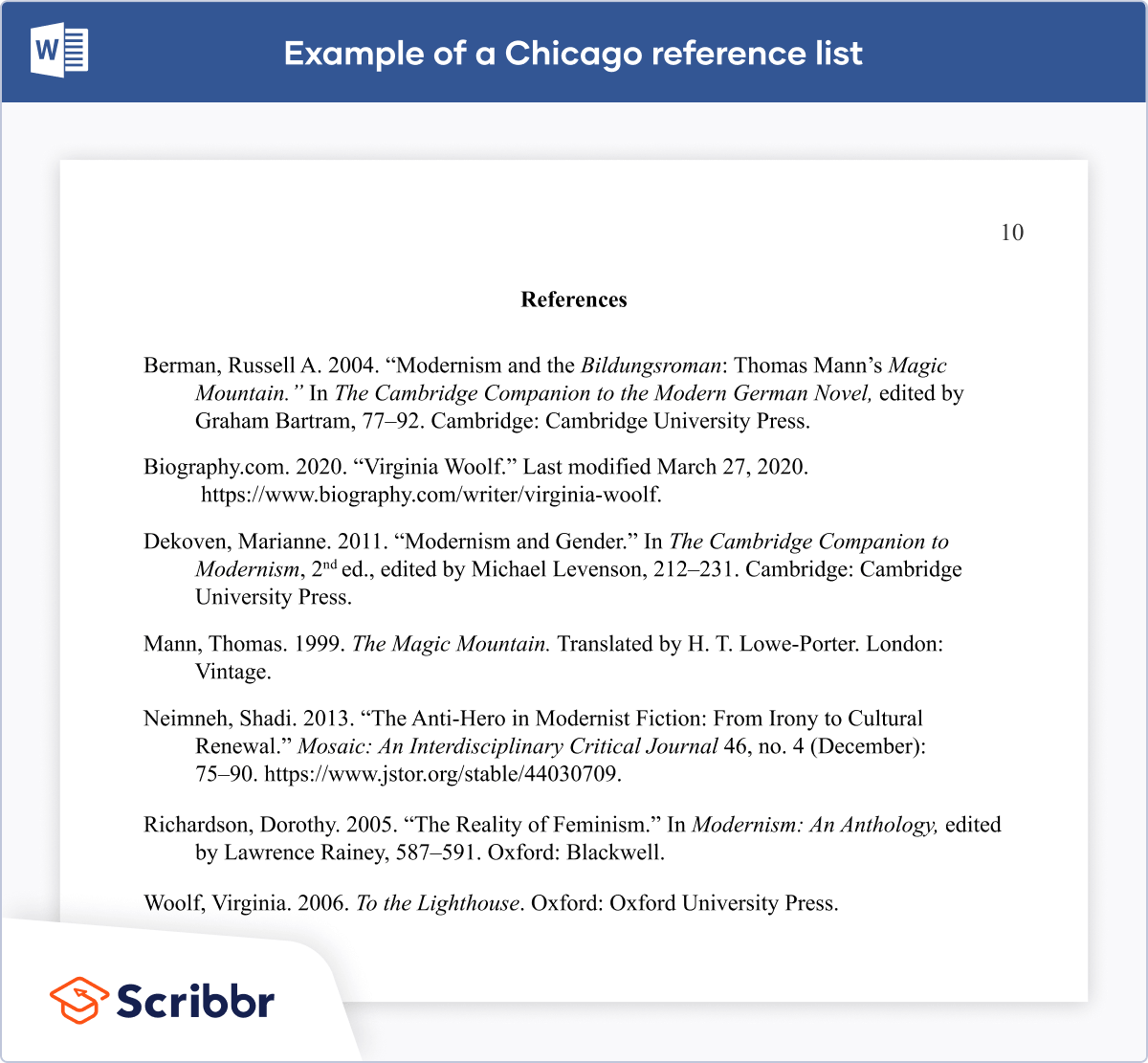Creating a Chicago Style Bibliography | Format & Examples
A Chicago style bibliography lists the sources cited in your text. Each bibliography entry begins with the author’s name and the title of the source, followed by relevant publication details. The bibliography is alphabetized by authors’ last names.
A bibliography is not mandatory, but is strongly recommended for all but very short papers. It gives your reader an overview of all your sources in one place. Check with your instructor if you’re not sure whether you need a bibliography.
Always make sure to pay attention to punctuation (e.g., commas, quotation marks, parentheses) in your citations.
Chicago style bibliography examples
Bibliography entries vary in format depending on the type of source. Templates and examples for the most common source types are shown below.
| Template | Author Last Name, First Name. Book Title: Subtitle. Edition. Place of publication: Publisher, Year. DOI/URL. |
| Example | Williams, John. Stoner. London: Vintage, 2003. |
- The edition is always abbreviated (e.g. 2nd ed. or rev. ed.).
- Only include the URL for books you consulted online.
| Template | Author Last Name, First Name. “Chapter Title.” In Book Title: Subtitle, edited by Editor First Name Last Name, page range. Place of publication: Publisher, Year. DOI/URL. |
| Example | Stewart, Bob. “Wag of the Tail: Reflecting on Pet Ownership.” In Enriching Our Lives with Animals, edited by John Jaimeson, 220-90. Toronto: Petlove Press, 2007. |
- Use this format to cite a chapter in a multi-authored book. If all the chapters in a book were written by the same person, reference the whole book.
- Begin the citation with the author of the chapter. The editor who compiled the book is listed later.
| Template | Author Last Name, First Name. “Article Title.” Journal Name Volume, no. Issue (Month Year): Page range. DOI/URL. |
| Example | Andreff, Wladimir, and Paul D. Staudohar. “The Evolving European Model of Professional Sports Finance.” Journal of Sports Economics 1, no. 3 (August 2000): 257–276. https://doi.org/10.1177/152700250000100304. |
- The page range identifies the location of the article within the journal issue.
- For articles accessed online, include a DOI (digital object identifier) where available, and a URL if not.
| Template | Author Last Name, First Name. “Page Title.” Website Name. Month Day, Year. URL. |
| Example | Scribbr. “Chicago Style Citation.” Accessed June 16, 2020. https://www.scribbr.com/category/chicago-style/. |
- If the author is unknown, list the organization or website name as author, and don’t repeat it later in the citation.
- If no publication date is listed, include an access date instead.
- The website name is not italicized, unless it is an online version of a newspaper or magazine.
Formatting the bibliography page
The bibliography appears at the end of your text. The heading Bibliography is bolded and centred at the top of the page.
Unlike the rest of a Chicago format paper, the bibliography is not double-spaced. However, add a single line space between entries.
If a bibliography entry extends onto more than one line, subsequent lines should be indented (hanging indent), as seen in the example below. This helps the reader to see at a glance where each new entry begins.
There are further guidelines for formatting a Chicago style annotated bibliography, in which you write a paragraph of summary and source evaluation under each source.
Author names in the bibliography
Author names in the bibliography are inverted: The last name comes first, then the first name(s). Sources are alphabetized by author last name.
If a source has no named author, alphabetize by the first word of the title or organization name that starts the entry. Ignore articles (“the,” “a,” and “an”) for the purposes of alphabetization.
Sources with multiple authors
For sources with more than one author, only the first author’s name is inverted; subsequent names are written in the normal order.
For texts with up to 10 authors, all the authors’ names should be listed in the order they appear in the source, separated by commas.
If there are more than 10 authors, list the first seven, followed by “et al.”
Multiple sources by the same author
If you include multiple works from the same author, only include the author name in the first entry. In subsequent entries, replace the name with three em dashes, followed by the rest of the citation formatted as normal. List the entries in alphabetical order by title.
———. Quartet. New York: W. W. Norton & Company, 1997.
———. Wide Sargasso Sea. London: Penguin, 1997.
Bibliography vs reference list
A reference list is mandatory in Chicago author-date style, where you cite sources in parentheses in the text. The only differences between a Chicago bibliography and a reference list are the heading and the placement of the date.
The reference list is headed “References.” In reference list entries, the publication date is placed immediately after the author’s name. This allows the reader to easily find a reference on the basis of the corresponding in-text citation.
Here's why students love Scribbr's proofreading services
Frequently asked questions about the Chicago bibliography
- How do I cite a source with no date in Chicago style?
-
When an online source does not list a publication date, replace it with an access date in your Chicago footnotes and your bibliography:
Example: Chicago bibliography entry with access date Scribbr. “How to Write a Research Paper.” Accessed June 9, 2020. https://www.scribbr.com/category/research-paper/.If you are using author-date in-text citations, or if the source was not accessed online, replace the date with “n.d.”
Example: Chicago author-date citation with no date (Scribbr, n.d.)To automatically generate accurate Chicago references, you can use Scribbr’s free Chicago reference generator.
- What is the difference between a Chicago reference list and a bibliography?
-
- A reference list is used with Chicago author-date citations.
- A bibliography is used with Chicago footnote citations.
Both present the exact same information; the only difference is the placement of the year in source citations:
- In a reference list entry, the publication year appears directly after the author’s name.
- In a bibliography entry, the year appears near the end of the entry (the exact placement depends on the source type).
There are also other types of bibliography that work as stand-alone texts, such as a Chicago annotated bibliography.
- Do I have to include a bibliography or reference list?
-
In Chicago author-date style, your text must include a reference list. It appears at the end of your paper and gives full details of every source you cited.
In notes and bibliography style, you use Chicago style footnotes to cite sources; a bibliography is optional but recommended. If you don’t include one, be sure to use a full note for the first citation of each source.
Cite this Scribbr article
If you want to cite this source, you can copy and paste the citation or click the “Cite this Scribbr article” button to automatically add the citation to our free Citation Generator.
Caulfield, J. (2024, April 09). Creating a Chicago Style Bibliography | Format & Examples. Scribbr. Retrieved April 23, 2024, from https://www.scribbr.com/chicago-style/bibliography/




